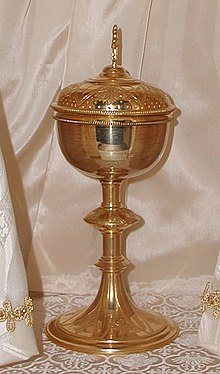|
Ciborium (container)
 A ciborium (plural ciboria; Medieval Latin ciborium "drinking cup", from the Ancient Greek κιβώριον kibōrion, "drinking cup"[1]) is a vessel, normally in metal. It was originally a particular shape of drinking cup in ancient Greece and Rome, but the word later came to refer to a large covered cup designed to hold hosts for, and after, the Eucharist, thus the counterpart (for the bread) of the chalice (for the wine). The word is also used for a large canopy over the altar of a church, which was a common feature of Early Medieval church architecture, now relatively rare. HistoryThe ancient Greek word referred to the cup-shaped seed vessel of the Egyptian water-lily nelumbium speciosum and came to describe a drinking cup made from that seed casing,[1] or in a similar shape. These vessels were particularly common in ancient Egypt and the Greek East. The word "ciborium" was also used in classical Latin to describe such cups,[2] although the only example to have survived is in one of Horace's odes (2.7.21–22).[3] In medieval Latin, and in English, "Ciborium" more commonly refers to a covered container used in Roman Catholic, Anglican, Lutheran and related churches to store the consecrated hosts of the sacrament of Holy Communion. It resembles the shape of a chalice but its bowl is more round than conical, and takes its name from its cover,[clarification needed] surmounted by a cross or other sacred design. In the early Catholic Church, Holy Communion was not kept in churches for fear of sacrilege or desecration; the religion was still largely illegal and subject to frequent persecutions. Later, the first ciboria were kept at homes to be handy for the Last Rites where needed. In churches, a ciborium is usually kept in a tabernacle or aumbry. In some cases, it may be veiled (see photograph below) to indicate the presence of the consecrated hosts. It is typically made, or at least plated, in a precious metal. Other containers for the host include the paten (a small plate) or a basin (for loaves of bread rather than wafers) used at the time of consecration and distribution at the main service of Holy Eucharist. A pyx is a small, circular container into which a few consecrated hosts can be placed. Pyxes are typically used to bring communion to the sick or housebound. Gallery
See alsoReferences
External linksWikimedia Commons has media related to Ciboria (container).
|



